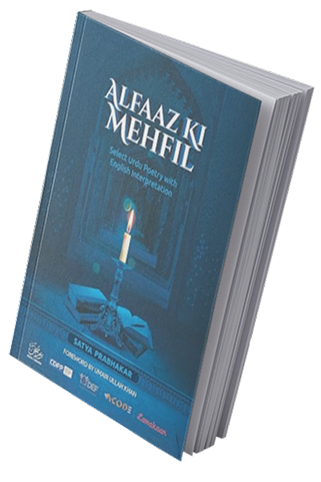Join Alfaaz ki Mehfil WhatsApp group and
get a new sher translation every morning (no other messages) by clicking on this link: https://chat.whatsapp.com/JrOvblyj43p3b8ASoQeY0E


2 Urdu ashaar / shayari (shers, couplets) by
Ameer Khusrau
1253-1325,
Patiali (Uttar Pradesh)
Ameer Khusrau Biography
Ameer Khusrau was born in 1253 in Patiali, a town in present-day Uttar Pradesh. He is often celebrated as one of the most remarkable figures in Indian cultural history. A poet, musician, scholar, and courtier, Khusrau served in the royal courts of several Delhi Sultans and became known as the “Parrot of India” for his brilliance in both poetry and prose. His father, Amir Saifuddin Mahmud, was a Turk from Central Asia who migrated to India, while his mother was of Indian origin. This blend of cultures deeply influenced Khusrau’s creative spirit and helped him bridge the worlds of Persian and Indian thought.
Khusrau began composing poetry at a young age and soon mastered Persian, the literary and administrative language of his time. His poetry reflected love, devotion, and the beauty of the human experience, written in a style that balanced sophistication with simplicity. He became a disciple of the Sufi saint Hazrat Nizamuddin Auliya, and his spiritual connection to the Sufi order shaped much of his later writing. His verses often expressed mystical love and divine longing, earning him reverence as a spiritual poet as well as a literary genius.
Ameer Khusrau’s contribution to music is as important as his literary legacy. He is credited with inventing or popularizing several classical instruments and styles, including the sitar and tabla, though historical accounts differ on the exact origins. He also played a key role in developing qawwali, a form of devotional music that continues to thrive in South Asia today. His blending of Persian and Indian melodic patterns laid the foundation for what later became known as Hindustani classical music.
He wrote numerous masnavis, ghazals, and riddles in Persian, along with verses in early forms of Hindavi, the precursor to modern Hindi and Urdu. His use of local language in poetry was revolutionary at a time when Persian dominated the literary scene. Among his famous works are Khamsa-e-Nizami, Tuhfat-us-Sighar, Qiran-us-Sa’dain, and Nuh Sipihr, all of which showcase his mastery of expression and his love for India.
Ameer Khusrau passed away in 1325, shortly after the death of his spiritual guide, Nizamuddin Auliya. He was buried near his teacher’s shrine in Delhi, where devotees still visit to pay homage. His legacy lives on in poetry, music, and culture, reminding generations that true art unites rather than divides. Through his words and melodies, Khusrau continues to echo the harmony between heart and heritage.
1 / 2: Ameer Khusrau
sakhi piya ko jo main na dekhun
to kaise kaaTuun andheri ratiyaan
the night of separation stretches like tresses
day of union short like life itself
my friend, if i don't see my beloved
how shall i endure these dark nights?
0
0
1
4
2 / 2: Ameer Khusrau
chal 'khusro' ghar aapne
rain bhai chahun des
the beloved rests on her bed
her face veiled by her tresses
come, 'khusro', let us go home
the night has spread all across
0
0
1
3
Featured Shaayars
543 Shaayars
Featured Themes

Urdu Poetry, Simply Told
classic Urdu shers with simple translations, poetic insights, and mini-dictionaries for every poetry lover...
A heartfelt collection of Classic Urdu shers...



Alfaaz Ki Mehfil is a curated space for timeless poetry celebrating words, emotions, and the enduring beauty of expression. From classic Urdu couplets to modern reflections, it brings together generations of poetic voices that speak of love, longing, hope, and the human soul.
Quick Links
